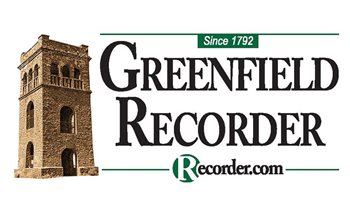‘Meant to only last the summer’: Amherst artist’s wheatpaste murals among those now decorating Montague
| Published: 06-13-2025 10:12 AM |
Earlier this year, three Massachusetts artists were chosen to create six wheatpaste murals total to decorate the town of Montague, a public art project funded by a $15,000 grant. The most local of the three – graphic designer and illustrator Sophie Foulkes – recently installed her murals at Montague Town Hall and 20 Masonic St. in Montague.
Foulkes, who grew up in Amherst and now splits her time between Amherst and Providence, Rhode Island, said that she appreciated the opportunity to honor the town.
“I just want [the murals] to be celebratory of Montague, and I want people to feel happy and see the creativity in play that happens there,” she said.
The other two artists were Aaron Meshon of Great Barrington and Ponnapa Prakkamakul of Cambridge.
Foulkes’ designs come from a list of elements and themes provided by the municipal arts organization RiverCulture. Foulkes’ chosen design elements included, among others, the Connecticut River, the Canalside Rail Trail, paper mill machinery, and a fish ladder, which represents “the perseverance of people in Montague.” As a child, Foulkes enjoyed visiting the Montague Book Mill and the Bitzer Hatchery with her family, which she said are some of her favorite parts of the community.
Foulkes used a combination of traditional and digital techniques to create her murals: she drew or painted her design elements by hand, then scanned them at a high resolution and digitally collaged all of the pieces together in Photoshop.
“This project was, by far, the largest project I’ve ever done,” she said.
Each artist who applied for the wheatpaste mural project could apply only to create murals for one of three pairs of locations. Suzanne LoManto, director of RiverCulture, said that 16 artists applied for the locations that went to Foulkes. The jury included LoManto, three community members, and two representatives from the Montague Town Hall. When it came time to vote, the decision was unanimous.
Article continues after...
Yesterday's Most Read Articles
“They really were impressed with the whimsical way that her work suggested landscapes and geography, and the amount of details that she put in that were really whimsical,” said LoManto. “So between the drawing style and then this really unique way that she suggests space, [her work] was very eye-catching to the jury.”
In April, Foulkes took part in a community engagement session in which Montague residents shared their ideas on several draft designs, putting sticky notes on drafts of her work to share what they liked about the pieces or what they thought might be good to add. Two weeks later, she submitted the final versions of her designs, which incorporated the residents’ feedback and ideas.
“I really enjoyed the community engagement aspect of it,” Foulkes said. “I really enjoyed getting to talk with so many different people and having their input and hearing their stories about the area and incorporating everybody’s feelings into the piece.”
Her next public art project, as of this writing, will be painting an electrical box in Providence in September. Before that, she’ll be teaching at Snow Farm, a fine art and craft studio in Williamsburg, in July.
There’s an unfortunate irony about this public beautification project: it’s not meant to last. Wheatpaste, true to its name, is an adhesive created from a mixture of wheat flour and water; it’s more often associated with guerrilla activism and street art than municipal projects. Wheatpasted posters and murals (more so than, for example, paint) are prone to degradation over time, caused by the elements.
“It’s meant to only last the summer, so that’s part of the joy, is that it’s only here for a bit,” Foulkes said. “I think hopefully it can be an incentive to create more public art.”
LoManto said a project like this is unique, which benefits the community – as far as she knows, “No other municipality has done six really large-scale temporary wheatpaste murals like this.”
“The people who live here get to say, ‘That’s what we got.’ They got it first,” she added.
LoManto hopes that people who come to see the murals take away an added appreciation for the Montague area.
“I hope that they just really enjoy them, and then I hope that they think about how much they enjoy coming to Montague and how much they enjoy spending time on the bike path, and they think about it as a place they might want to come more often,” she said. “More important, I really want to enhance the quality of life of the people living here. That’s number one.”
Carolyn Brown can be reached at cbrown@gazettenet.com.













 ‘The freedom to be silly’: Hilltown Youth Recovery Theatre helps campers heal in mid-air
‘The freedom to be silly’: Hilltown Youth Recovery Theatre helps campers heal in mid-air How to grow a creative community: Meet the eight artists selected for CitySpace’s 2025 Pay It Forward program
How to grow a creative community: Meet the eight artists selected for CitySpace’s 2025 Pay It Forward program The melody lingers on: 85 years later, 102-year-old Montague resident to hear Glenn Miller band again
The melody lingers on: 85 years later, 102-year-old Montague resident to hear Glenn Miller band again Let’s Talk Relationships: The joy of feeling like yourself: Transitioning is about authenticity
Let’s Talk Relationships: The joy of feeling like yourself: Transitioning is about authenticity
